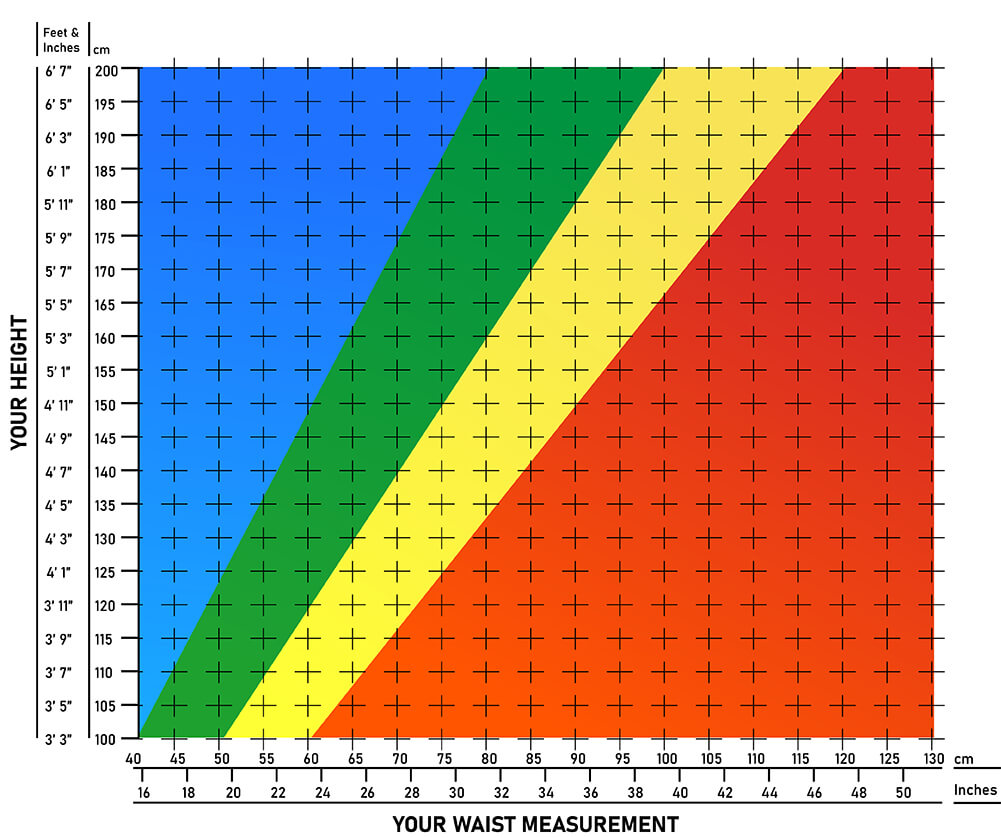Waist-to-Height Ratio Calculator - Your Abdominal Health Index
 Give Feedback
Give FeedbackWhat is Waist-to-Height Ratio?
Waist-to-Height Ratio (WHtR) is a simple yet effective health indicator that helps assess your body fat distribution, particularly around your abdomen. By comparing your waist circumference to your height, WHtR provides valuable insights into your abdominal fat levels. Compared to other health metrics like BMI, waist-to-height ratio is considered a better reflection of abdominal fat’s impact on health, especially concerning cardiovascular and metabolic health.
How to Calculate Waist-to-Height Ratio
Calculating your waist-to-height ratio is straightforward. You only need to know your waist circumference and height. The formula is:
Waist-to-Height Ratio = Waist Circumference (cm) ÷ Height (cm)
For example, if your waist is 80 cm and your height is 160 cm, the calculation would be:
80 ÷ 160 = 0.5
This number represents your waist-to-height ratio. Sounds simple, right? Now let’s talk about how to interpret this number.
Why is Waist-to-Height Ratio Important?
You may already know that abdominal fat (especially visceral fat) poses a greater health risk than fat in other areas of the body. Waist-to-height ratio is a key indicator of abdominal fat accumulation, which is linked to an increased risk of heart disease, diabetes, and high blood pressure.
Unlike BMI, which generally assesses weight in relation to height, waist-to-height ratio specifically focuses on abdominal fat. While BMI can give a rough idea of whether someone is underweight, normal weight, or overweight, it does not distinguish between fat and muscle. Waist-to-height ratio, on the other hand, provides a more accurate reflection of excess abdominal fat and can help you monitor your health more effectively.
A Simple Example
Let’s say you’re 170 cm tall with a waist circumference of 80 cm. To calculate your waist-to-height ratio:
80 ÷ 170 = 0.47
With this result, you can assess whether you’re in a healthy range. For most adults, a waist-to-height ratio above 0.5 may indicate excess abdominal fat and an increased risk of health issues. If your waist-to-height ratio is high, consider taking steps like adjusting your diet and increasing physical activity to improve your health.
How to Use the Waist-to-Height Ratio Calculator
Using the waist-to-height ratio calculator is easy. Just follow these simple steps to quickly get your waist-to-height ratio and understand your health status.
1. Enter Your Waist Circumference and Height
- Waist Circumference: Enter your waist measurement. You can use either "inches" or "centimeters" (selectable from a dropdown menu).
- Tip: To measure your waist, use a soft tape measure around your abdomen at the level just above your navel.
- Height: Enter your height in either "feet" or "centimeters."
- Note: Stand straight, feet together, and don’t wear shoes when measuring for the most accurate result.
For more information on how to measure, see our Body Measurement Guide.
2. View Your Results
Once you click the “Calculate” button, the calculator will instantly display your waist-to-height ratio (e.g., 0.44). The result will be shown in both numerical value and visual representation for easy understanding.
- Result Interpretation: The calculator will compare your result to the health reference standards and display your current health status.
- Green Zone: Healthy range, indicating good control of abdominal fat.
- Yellow Zone: Slightly elevated, suggesting you should monitor your lifestyle.
- Red Zone: Higher risk, recommending immediate action to improve health.
- Visual Guide: The result is displayed on a color-coded chart to give you a quick, intuitive understanding of where your waist-to-height ratio falls.
3. Get Health Insights
The calculator not only provides your waist-to-height ratio but also offers simple health suggestions based on your result, such as:
- Current status (Healthy, Needs Attention, High Risk, etc.)
- Suggested actions (e.g., increasing exercise, adjusting diet)
- Importance of maintaining a healthy lifestyle
For instance, if your waist-to-height ratio falls in the green zone, the calculator will congratulate you: "Congratulations! Your waist-to-height ratio is in the healthy range." If it’s high, the calculator will provide encouraging suggestions for improvement.
Waist-to-Height Ratio Health Reference Standards

1. Underweight (Waist-to-Height Ratio below 0.4)
Status Description: Your waist-to-height ratio is low, indicating you have less abdominal fat. However, this could also mean you may have insufficient energy reserves, which can affect immune function and overall health.
Health Recommendations:
- Diet Adjustment: Increase intake of healthy fats and high-quality proteins, such as avocado, nuts, eggs, and lean meats, to improve energy reserves.
- Strength Training: Incorporate strength exercises, like squats and bench presses, to increase muscle mass and improve overall physical health.
- Avoid Excessive Dieting: Don’t overly restrict calories—maintain a balanced diet with enough carbohydrates and fats.
- Regular Check-ups: Ensure your body is in good health by monitoring your energy levels and nutrient intake.
2. Healthy (Waist-to-Height Ratio between 0.4 and 0.5)
Status Description: Congratulations! Your waist-to-height ratio is in the healthy range, indicating good control of abdominal fat and a lower health risk.
Health Recommendations:
- Maintain Your Lifestyle: Keep eating a balanced diet with a good mix of carbohydrates, proteins, healthy fats, and dietary fiber.
- Regular Exercise: Aim for at least 150 minutes of moderate-intensity aerobic exercise each week, such as brisk walking, cycling, or swimming, to improve cardiovascular health.
- Good Sleep Habits: Ensure sufficient sleep and avoid late-night habits to support overall well-being.
- Positive Mental Health: Keep a positive outlook and manage stress, as emotional well-being is key to maintaining long-term health.
3. Overweight (Waist-to-Height Ratio between 0.5 and 0.6)
Status Description: Your waist-to-height ratio is elevated, indicating excess abdominal fat. This could increase your risk of cardiovascular diseases, diabetes, and other health issues.
Health Recommendations:
- Dietary Adjustments: Cut back on high-sugar, high-fat, and high-calorie foods like fried foods and sweets. Instead, eat more vegetables, whole grains, and lean proteins to better manage calorie intake.
- Increase Exercise: Engage in moderate-intensity aerobic exercises, such as brisk walking or cycling, and include core exercises (e.g., sit-ups) to reduce abdominal fat.
- Healthy Habits: Monitor your waist circumference and weight regularly, and make gradual lifestyle changes to adopt a healthier diet and exercise routine.
4. Obesity (Waist-to-Height Ratio above 0.6)
Status Description: Your waist-to-height ratio is high, indicating significant abdominal fat accumulation, which significantly increases your risk for heart disease, diabetes, and other chronic conditions.
Health Recommendations:
- Diet Management: Cut down on fried foods, sugary snacks, and high-calorie processed foods. Focus on fiber-rich foods, like leafy greens, whole grains, and low-fat proteins.
- Low-Intensity Exercise: Start with low-impact activities like walking or swimming, and gradually increase intensity to burn abdominal fat.
- Consistent Sleep: Ensure you get enough rest to support metabolic health.
- Seek Professional Guidance: If your waist and weight don’t improve, consult a doctor or health coach to create a personalized health plan.
Frequently Asked Questions (FAQ)
Q1: Is the Waist-to-Height Ratio suitable for everyone?
A: Waist-to-height ratio is a simple and widely applicable health assessment tool, especially useful for adults. However, it may need to be adjusted for the following groups:
- Children and Teenagers: Since they are still growing, height and waist size change with age, so individual adjustments are needed.
- Pregnant Women: During pregnancy, abdominal size naturally increases, so waist-to-height ratio is not an accurate health measure.
- Athletes or Fitness Enthusiasts: These individuals may have higher muscle mass, which can skew waist measurement, but abdominal fat may not be excessive.
- Individuals with Special Conditions: Medical conditions or surgeries may affect body shape, potentially affecting the accuracy of the waist-to-height ratio.
Recommendation: For these groups, it’s best to consult a healthcare professional for a more tailored assessment using other indicators (e.g., body fat percentage, BMI).
Q2: If my waist-to-height ratio is outside the healthy range, does that mean I have a health problem?
A: Not necessarily! The waist-to-height ratio is a risk assessment tool that highlights the potential for abdominal fat accumulation and its associated health risks, such as cardiovascular disease or diabetes. However, it doesn’t diagnose specific conditions.
- Factors Affecting Results: Lifestyle choices, genetics, and muscle mass can all influence the ratio.
- Health Risk Warning: A higher waist-to-height ratio suggests more abdominal fat, which may increase health risks, but it doesn't mean you are already sick.
- Next Steps:
- Adopt Healthy Habits: Adjust your diet, exercise, and sleep patterns to gradually improve your health.
- Check Other Metrics: Consider checking additional health indicators like body fat percentage, blood pressure, and blood sugar levels for a more complete picture of your health.
- Regular Monitoring: Keep track of your waist-to-height ratio over time to see if it improves with changes in lifestyle.
- Seek Professional Help: If concerned, consult a healthcare provider for more personalized advice.
Remember: The goal of the waist-to-height ratio is to help you spot potential issues early so you can take action—not to add stress. Positive lifestyle changes will help you achieve better health over time!
 Disclaimer
Disclaimer

 EN
EN






 Embed Code
Embed Code